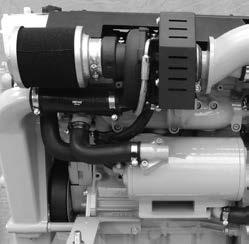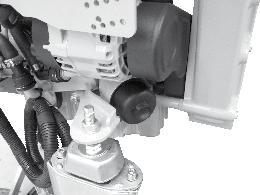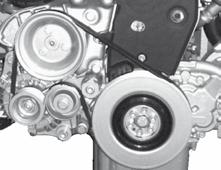
7 minute read
7 Lay-up / Winter storage procedure
In case of lay-up for a long period the storage procedures as described in this chapter should be carried out.
A long period means a period longer than 3 months, for example, during the winter period.
Make sure that the engine compartment is well ventilated during the winter period.
Good ventilation prevents damp in the engine compartment, thus preventing corrosion of the engine from occurring. The engine should be inspected at the start of the storage period and any necessary repairs should be carried out.
Consult a Vetus Dealer if help is required with this.
Inspections and maintenance work to be carried out are:
7 Lay-up / Winter storage procedure
Inspections and maintenance work to be carried out:
1 Check the zinc anodes.
page
76
2 Clean the engine, remove any salt. Paint any rust spots and spray the whole engine with a protective medium, for example CRC protective 6-66. 78
3 Drain off the water from the fuel system and fill the fuel tank. 78
4 Make sure that the engine fuel system is filled with a fuel mixture with protective properties. 79
5 Flush out the raw water circuit with fresh water and if necessary fill with antifreeze. Clean the heat exchanger if necessary. 80
6 Make sure that the cooling system is filled with a suitable anti-freeze. 81
7 Change the oil filter and the engine oil. 82
8 Change the oil in the gearbox. 82
9 Grease moving parts of the engine, including the turbo. 83
10 Disconnect the battery cables, charge the batteries if necessary and grease the battery terminals. 85
7 Lay-up / Winter storage procedure

1 Zinc anode
There are 5 zinc anodes in the raw water circuit to protect engine parts that come into contact with the external water from galvanic corrosion. The speed at which the zinc anodes are sacrificed depends on many external factors. The arrows indicate where the zinc anodes are located. The zinc anodes are marked with black ink.
7 Lay-up / Winter storage procedure
Check the zinc anodes; a new zinc anode is 15 mm in length; if a zinc anode is shorter than 7 mm it should be replaced. Check and replace the zinc anodes as follows:
• Stop the engine.
• Close the sea cock.
• Remove the zinc anodes from the heat\ exchanger housing and the after cooler respectively. • Replace the (new) zinc anodes and the copper rings.
Use a sealant, for example Loctite® Thread
Sealant with PTFE or LOXEAL® 18-10 Pipe
Sealant.
• Open the sea cock, start the engine and check for leaks.
7 Lay-up / Winter storage procedure
2 Corrosion protection 3 Fuel system

The various parts of the engine (except the engine block) have been treated with an anti-corrosion protective medium. In order to prevent corrosion, the engine should be rinsed off to remove any salt residues. If there is any corrosion, the paint should be touched up. Engine parts that become hot must be touched up with heat-resistant paint. • Drain the water from the water separator/ fuel filter and the fuel tank.
Ensure that the tank is completely filled with fuel. • Install a new fuel filter. (page 54)
7 Lay-up / Winter storage procedure
Caution
Never run the engine under load with this mixture of fuel and oil.
tip!
Combine running the engine with the protective fuel mixture with flushing the raw water circuit with fresh water, see ‘Winter storage procedure - Raw water cooling system’.
4 Protective fuel mixture
• Connect the fuel supply pipe to a can filled with protective diesel fuel, for example ‘Calibration Fluid’ (ISO 4113) or with a mixture of 1 part of engine oil [1] to 9 parts of clean fuel [2] .
• Use this mixture to run the engine at no load for approx. 5 minutes.
• Stop the engine. [1] Engine oil with protective properties.
E.g.: - Vetus Marine Diesel Engine Oil 15W40 - Shell Nautilus Premium Inboard 15W-40 [2] Only use DIN EN 590 Diesel fuel.
Preferably water-free fuel.
Collect some fuel from the return pipe, while engine is running.
7 Lay-up / Winter storage procedure
tip!
Combine flushing the raw water circuit with fresh water with running the engine with the protective fuel mixture, see ‘Winter storage procedure - Protective fuel mixture’
Heat exchanger
Only clean the heat exchanger if this is absolutely necessary, see page. 68.
Raw water pump
Check the impeller of the raw water pump at least once every two years, see page 58.
5 Raw water cooling system
• Close the sea cock.
• Remove the lid of the water strainer.
• If necessary, clean the raw water strainer. • Connect the raw water intake to a fresh water (tap water) supply or a tank containing fresh water. Open the tap and allow the engine to idle for at least 5 minutes to remove any salt and contamination from the raw water cooling system.
Make sure that there is a sufficient supply of water to prevent the engine from overheating. • Stop the engine and close the sea cock.
• The raw water system must be protected in areas where the temperature drops to below zero during the winter.
Pour 1 litre (1/4 gallon) of anti-freeze (preferably a non-toxic biodegradable anti-freeze) into the water strainer and run the engine until the anti-freeze has disappeared into the cooling system.
7 Lay-up / Winter storage procedure
tip!
Protect the sea cock as follows: With the motor stopped.
• Place the sea cock in a position that it is just opening. • Pour a small amount of non-toxic biodegradable anti-freeze into the raw water strainer.
• Close the sea cock as soon as it is filled with anti-freeze.

Anti-freeze can be toxic. Take care that no anti-freeze is spilled into the waterway
• Check the seal between the lid and housing after cleaning and re-assembling the strainer.
An improperly sealed lid will result in air sucked in by the raw water pump which again will result in overheating of the engine To avoid corrosion during winter storage the cooling system must be filled with an antifreeze/water mixture (or a coolant).
For specifications see page 111. N.B. Replacing the coolant is only necessary if the coolant present in the cooling system offers insufficient protection against temperatures below 0˚C (32˚F).
For coolant replacement see page 63.
6 Fresh water cooling system
7 Lay-up / Winter storage procedure


7 Lubrication system
With the engine still at operating temperature: (If not, run the engine until warm, then turn off.) Replace the oil filter and change the engine oil; use oil with protective properties. See page 43.
For quantity and oil specification see page 108. • Stop the engine and change the oil of the gearbox. (page. 51 and 52)
8 Changing the gearbox oil
7 Lay-up / Winter storage procedure
9 Greasing moving parts
For a good working of the engine it is essential to grease a number of moving parts on the outside of the engine or to spray them with oil.
Turbocharger
The turbocharger is a variable geometry type (VGT). The operating mechanism for this is on the outside of the turbo. This operating mechanism must be free of corrosion and well greased if it is to work on the best possible way. • Apply long-life water-resistant lithiumbased grease, for example ‘ZEP RED LITHI-
UM GREASE’, to the operating mechanism.
• Then spray the cast-iron housing and the aluminium parts of the turbo with liquid lubricant containing Teflon®, for example
‘ZEP 2000.’
• Disconnect the hose connecting the turbo to the after cooler from the turbo.
Remove any oil residue from the surface of the turbo exhaust and then replace the hose.
• Remove the air filter. Remove any oil residue from the surface of the turbo intake and then replace the hose.
• Clean the air filter if necessary, see page 50

7 Lay-up / Winter storage procedure

10 Belt tensioner
• Spray the spring and the rotation point of the belt tensioner with a liquid lithium- based lubricant.
Be careful not to get any lubricant on the belt!
7 Lay-up / Winter storage procedure
11 Electrical system
• Disconnect the battery cables. • Charge batteries during winter lay-up regularly if required! • Follow the recommendations given on pages 46 to 48 or consult the recommendations given by the battery supplier for inspection and maintenance of the batteries.







